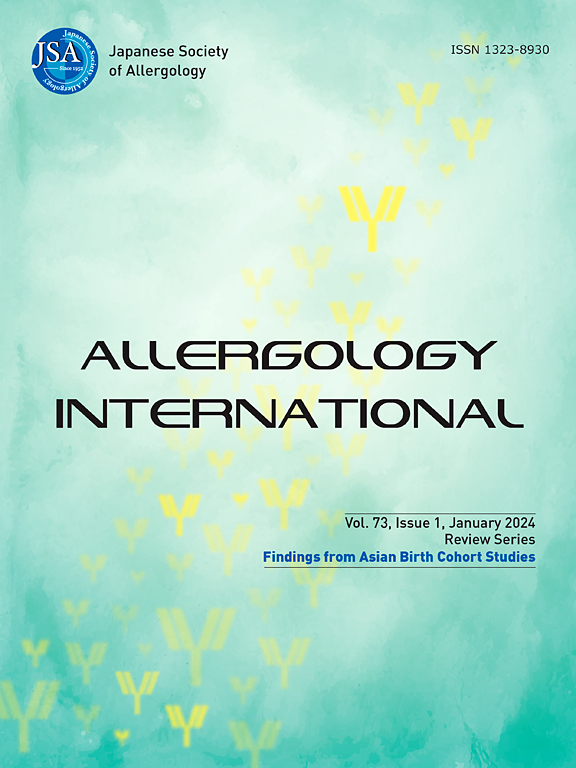The gut–organ axis: Clinical aspects and immune mechanisms
IF 6.2
2区 医学
Q1 ALLERGY
引用次数: 0
Abstract
The gut-brain axis exemplifies the bidirectional connection between the intestines and the brain, as evidenced by the impact of severe stress on gastrointestinal symptoms including abdominal pain and diarrhea, and conversely, the influence of abdominal discomfort on mood. Clinical observations support the notion of the gut–brain connection, including an increased prevalence of inflammatory bowel disease (IBD) in patients with depression and anxiety, as well as the association of changes in the gut microbiota with neurological disorders such as multiple sclerosis, Parkinson's disease, stroke and Alzheimer's disease. The gut and brain communicate via complex mechanisms involving inflammatory cytokines, immune cells, autonomic nerves, and gut microbiota, which contribute to the pathogenesis in certain gut and brain diseases. Two primary pathways mediate the bidirectional information exchange between the intestinal tract and the brain: signal transduction through bloodstream factors, such as bacterial metabolites and inflammatory cytokines, and neural pathways, such as neurotransmitters and inflammatory cytokines within the autonomic nervous system through the interaction between the nerve cells and beyond. In recent years, the basic mechanisms of the pathophysiology of the gut-brain axis have been gradually elucidated. Beyond the gut-brain interaction, emerging evidence suggests the influence of the gut extends to other organs, such as the liver and lungs, through intricate inter-organ communication pathways. An increasing number of reports on this clinical and basic cross-organ interactions underscore the potential for better understanding and novel therapeutic strategies targeting inter-organs networks. Further clarification of interactions between multiorgans premises transformative insights into cross-organ therapeutic strategies.
肠-器官轴:临床方面和免疫机制。
肠脑轴体现了肠与脑之间的双向联系,重度应激对腹痛、腹泻等胃肠道症状的影响,以及腹部不适对情绪的影响都证明了这一点。临床观察支持肠脑连接的概念,包括抑郁症和焦虑症患者中炎症性肠病(IBD)的患病率增加,以及肠道微生物群变化与多发性硬化症、帕金森病、中风和阿尔茨海默病等神经系统疾病的关联。肠道和大脑通过包括炎症细胞因子、免疫细胞、自主神经和肠道微生物群在内的复杂机制进行交流,这有助于某些肠道和大脑疾病的发病机制。两个主要途径介导肠道和大脑之间的双向信息交换:通过血液因子的信号转导,如细菌代谢物和炎症细胞因子;以及神经通路,如神经递质和炎症细胞因子在自主神经系统内通过神经细胞和外部细胞之间的相互作用。近年来,肠脑轴病理生理的基本机制逐渐被阐明。除了肠道-大脑的相互作用,新出现的证据表明,肠道的影响通过复杂的器官间交流途径延伸到其他器官,如肝脏和肺部。越来越多的关于这种临床和基本跨器官相互作用的报道强调了更好地理解和针对器官间网络的新治疗策略的潜力。进一步阐明多器官之间的相互作用前提是跨器官治疗策略的变革性见解。
本文章由计算机程序翻译,如有差异,请以英文原文为准。
求助全文
约1分钟内获得全文
求助全文
来源期刊

Allergology International
ALLERGY-IMMUNOLOGY
CiteScore
12.60
自引率
5.90%
发文量
96
审稿时长
29 weeks
期刊介绍:
Allergology International is the official journal of the Japanese Society of Allergology and publishes original papers dealing with the etiology, diagnosis and treatment of allergic and related diseases. Papers may include the study of methods of controlling allergic reactions, human and animal models of hypersensitivity and other aspects of basic and applied clinical allergy in its broadest sense.
The Journal aims to encourage the international exchange of results and encourages authors from all countries to submit papers in the following three categories: Original Articles, Review Articles, and Letters to the Editor.
 求助内容:
求助内容: 应助结果提醒方式:
应助结果提醒方式:


